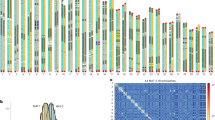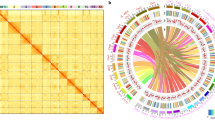Abstract
Arbuscular mycorrhizal fungi (AMF) are ancient asexually reproducing organisms that form symbioses with the majority of plant species, improving plant nutrition and promoting plant diversity1,2. Little is known about the evolution or organization of the genomes of any eukaryotic symbiont or ancient asexual organism. Direct evidence shows that one AMF species is heterokaryotic; that is, containing populations of genetically different nuclei3. It has been suggested, however, that the genetic variation passed from generation to generation in AMF is simply due to multiple chromosome sets (that is, high ploidy)4. Here we show that previously documented genetic variation in Pol-like sequences, which are passed from generation to generation, cannot be due to either high ploidy or repeated gene duplications. Our results provide the clearest evidence so far for substantial genetic differences among nuclei in AMF. We also show that even AMF with a very large nuclear DNA content are haploid. An underlying principle of evolutionary theory is that an individual passes on one or half of its genome to each of its progeny. The coexistence of a population of many genomes in AMF and their transfer to subsequent generations, therefore, has far-reaching consequences for understanding genome evolution.
This is a preview of subscription content, access via your institution
Access options
Subscribe to this journal
Receive 51 print issues and online access
$199.00 per year
only $3.90 per issue
Buy this article
- Purchase on Springer Link
- Instant access to full article PDF
Prices may be subject to local taxes which are calculated during checkout



Similar content being viewed by others
References
Smith, S. E. & Read, D. J. Mycorrhizal Symbiosis (Academic, San Diego, 1997)
Van der Heijden, M. G. A. et al. Mycorrhizal fungal diversity determines plant biodiversity, ecosystem variability and productivity. Nature 396, 69–72 (1998)
Kuhn, G., Hijri, M. & Sanders, I. R. Evidence for the evolution of multiple genomes in arbuscular mycorrhizal fungi. Nature 414, 745–748 (2001)
Pawlowska, T. E. & Taylor, J. W. Organization of genetic variation in individuals of arbuscular mycorrhizal fungi. Nature 427, 733–737 (2004)
Schüssler, A. Glomales SSU rRNA gene diversity. New Phytol. 144, 205–207 (1999)
Corradi, N. et al. Monophyly of b-tubulin and H+-ATPase gene variants in Glomus intraradices: consequences for molecular evolutionary studies of AM fungal genes. Fungal Genet. Biol. 41, 262–273 (2004)
Rosendahl, S. & Taylor, J. W. Development of multiple genetic markers for studies of genetic variation in arbuscular mycorrhizal fungi using AFLP. Mol. Ecol. 6, 821–829 (1997)
Helgason, T. et al. Phylogeny of the glomerales and diversisporales (Fungi: Glomeromycota) from actin and elongation factor 1-alpha sequences. FEMS Microbiol. Lett. 229, 127–132 (2003)
Hijri, M. & Sanders, I. R. The arbuscular mycorrhizal fungus Glomus intraradices is haploid and has a small genome size in the lower limit of eukaryotes. Fungal Genet. Biol. 41, 253–261 (2004)
Hosny, M., Gianinazzi-Pearson, V. & Dulieu, H. Nuclear DNA content of 11 fungal species in Glomales. Genome 41, 422–428 (1998)
Bianciotto, V. & Bonfante, P. Quantitation of the nuclear DNA content of two arbuscular mycorrhizal fungi. Mycol. Res. 96, 1071–1076 (1992)
Graur, D. & Li, W. H. Fundamentals of Molecular Evolution (Sinauer, Sunderland, 2000)
Hosny, M. GC Content, Genome Size of Glomales. Genome Complexity and Polymorphism of rDNA in Scutellospora castanea. Thesis, Univ. Burgundy (1997)
Giovannetti, M., Azzolini, D. & Citernesi, A. S. Anastomosis formation and nuclear and protoplasmic exchange in arbuscular mycorrhizal fungi. Appl. Environ. Microbiol. 65, 5571–5575 (1999)
Acknowledgements
We thank the Swiss National Science Foundation for supporting this work with a fellowship awarded to I.R.S. under the professorial fellowship programme. The authors thank J. C. Dodd and A. Rodriguez for providing fungal material, and H. Dulieu for comments on the manuscript. We also wish to acknowledge the work on re-association kinetics by M. Hosny, who sadly passed away before his work could be published.
Author information
Authors and Affiliations
Corresponding author
Ethics declarations
Competing interests
The authors declare that they have no competing financial interests.
Supplementary information
Supplementary Methods
This contains details of Supplementary Methods, including real-time PCR for quantification of PLS copy number, analysis of re-association kinetics data and additional references. (DOC 38 kb)
Supplementary Figure S1
The original re-association curve (ECot curve) obtained for Scutellospora castanea genomic DNA. (JPG 40 kb)
Rights and permissions
About this article
Cite this article
Hijri, M., Sanders, I. Low gene copy number shows that arbuscular mycorrhizal fungi inherit genetically different nuclei. Nature 433, 160–163 (2005). https://doi.org/10.1038/nature03069
Received:
Accepted:
Issue Date:
DOI: https://doi.org/10.1038/nature03069
This article is cited by
-
Specificity of assemblage, not fungal partner species, explains mycorrhizal partnerships of mycoheterotrophic Burmannia plants
The ISME Journal (2021)
-
Divergence of Funneliformis mosseae populations over 20 years of laboratory cultivation, as revealed by vegetative incompatibility and molecular analysis
Mycorrhiza (2018)
-
New method for the identification of arbuscular mycorrhizal fungi by proteomic-based biotyping of spores using MALDI-TOF-MS
Scientific Reports (2017)
Comments
By submitting a comment you agree to abide by our Terms and Community Guidelines. If you find something abusive or that does not comply with our terms or guidelines please flag it as inappropriate.



